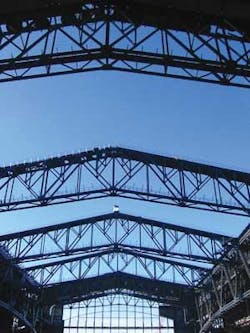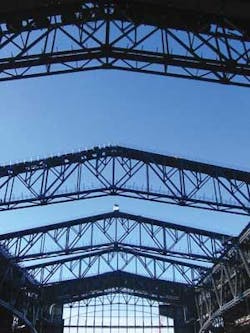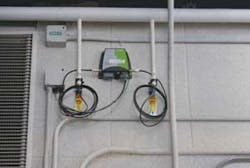Raising the roof with industrial wireless Ethernet
Size and exposure to extreme elements required a wireless solution for moving Lucas Oil Stadium’s massive retractable roof and “window walls.”
Today’s NFL stadiums are more than just a place to watch football. Retractable roofs and other architectural features attract nearly as much attention as the teams that play there.
Lucas Oil Stadium, the new home of the Indianapolis Colts that opened in August 2008, was envisioned as an architectural match to the existing cityscape. Like most of today’s multi-purpose venues, the stadium will host hundreds of non-football events, making a retractable roof a necessity. The stadium also features a unique moveable “window wall” in the north end zone, which offers a commanding view of the city whether opened or closed.
Minneapolis-based Uni-Systems (www.uni-systems.com), a designer of kinetic architecture and part of the stadium’s design team, originally developed moveable architecture for the aerospace industry when it was founded more than 40 years ago. Today, the com- pany has expanded into many other industries, and is a leader in the design, fabrication, and installation of mechanization components for sports stadiums.
A growing number of stadiums are incorporating retractable roofs and other kinetic features. Uni-Systems has been involved in five of the last seven retractable sports-stadium roofs built in North America: Reliant Stadium, Minute Maid Park, University of Phoenix Stadium, Lucas Oil Stadium, and Cowboys Stadium.
Size matters, weather, too
To ensure that both the window wall and the retractable roof open and close safely and efficiently, Uni-Systems needed clear and reliable communication in an indus- trial design. According to Lennart Nielsen, electrical engineering manager for Uni-Systems, a wireless solution is ideal for the stadium’s moving architecture.
Hard-wired solutions were expensive and not practical because of the 100-plus feet of the building elements’ movement, and because of prolonged exposure to ice and snow. Working with Phoenix Contact, Uni-Systems decided on industrial wireless Ethernet for several communication applications at the stadium. The flexibility, simple installation, and cost savings of wireless gave it several advantages over traditional cable-based circuits. Because of the stadium’s steel structure and moving components, however, special considerations needed to be taken during the wireless installation. “While the steel frame wasn’t directly interfering with signals, we needed to be inventive with how we located the radios,” Nielsen explains.
Lucas Oil Stadium’s sliding window wall expands on the idea of a simple sliding door. These massive windows, when retracted, give stadium patrons an outdoor experience in an indoor setting. The moveable window wall panels each stand 88 feet high by 36 feet wide. Even with a small overlap, the six glass-clad panels combine to create a more than 18,000-square-foot window. When opening, three panels move to one side, and three to the other. When in the closed position, the entire perimeter of each wall panel is sealed with weather seals.
Each panel is supported by two hardened steel wheels, each driven by a 3 HP motor. At the touch of the button, the six wall panels move simultaneously between the open and closed position in four minutes. Whether open or shut, the window wall provides breathtaking views of the Indianapolis cityscape.
When opening or closing the wall, the data must pass between each individual wall panel, as well as the main controller. Each panel has a variable frequency drive (VFD) and an I/O module. Controlling the wall requires a fast and reliable communication solution.
Radio-controlled windows
Uni-Systems installed Phoenix Contact industrial wireless Ethernet radios, configured in “bridge” mode. The radios use Modbus TCP/IP protocol to control the movement of the walls. The original plans called for a single fixed radio to act as a master control for the six individual panels. A DIN-mountable radio unit and a single 10 dBi (a unit of sound that measures acoustical and elec- trical power) omni-directional antenna were installed on each panel.
The wall’s moveable architecture, however, proved to be a challenge for antenna placement. And finding a single location for a fixed radio to communicate with all six moveable panels through the entire opening/closing process proved impos- sible. To avoid interference with most wireless Ethernet installations that operate in the 2.4 GHz spectrum, the industrial wireless Ethernet radios operate in the 5.8 GHz spectrum. This results in less radio interference, but more susceptibility to signal degradation due to poor line-of-sight.
“Because there were so many steel beams in the area, we had trouble trying to get line-of-sight back to the transceiver,” says Nielsen. “The original transceiver was located behind one of the panels, but when you got up close, the panels would shield their neighbors from the signals.”
The solution was to put a second fixed transceiver at ground level. Each fixed radio now communicates with individual radios on three of the moving wall panels.
The retractable roof at Lucas Oil Stadium comprises two panels, each approximately 160 feet long by 600 feet wide, and together weighing 2.5 million pounds. They meet at the top of the roof to form the peak when in the closed position, and slide down along five parallel rails to rest over the lower half of the roof when in the open position. When the roof is closed, a large moveable cap covers the entire peak of the roof and provides a weather-tight seal between the two panels.
To monitor the roof, two pairs of cameras are mounted on each roof panel. Each pair is at least 600 feet apart from the other pair on that panel. These cameras send real-time images to an HMI screen on a personal computer, where the operator can operate, monitor, and troubleshoot the retractable roof. In addition to the live video, the computer screen displays the speed and position of the roof panels, along with the status of motors, brakes, operable rail clamps, and other components.
Nielsen compares the live video feed to a security blanket for the operator: “The video gives a visual confirmation that things are moving, and there’s nothing in the direct path.” The video feed eliminates the need for a worker to manually inspect the roof during the opening and closing process.
To ensure reliable communication between the roof and the control room, Uni-Systems again turned to Phoenix Contact’s industrial wireless Ethernet radios. One master radio with 10 dBi outdoor omni-directional antennas was placed on the fixed structure between the bi-parting roof panels at one end of the peak. This radio communicates (in bridge mode) with radios mounted on each of the two moving roof panels, directly in line with the fixed radio. These radios have two 10 dBi omni-directional antennas each, and communicate not only back to the fixed radio, but also across the 600-foot roof span to a radio mounted on the last rail–which has a single 18 dBi directional antenna. This network of five radios provides video from the eight Ethernet cameras.
As with the window walls, these radios were set to operate in the 5 GHz spectrum where there is less noise interference. Since the industrial radios are IP54-rated, they operate effectively in Indianapolis’s tough winter conditions.
Safe and seamless
While a hard-wired solution was virtually impossible in this situation, Uni-Systems found Phoenix Contact’s industrial wireless Ethernet solutions offered industrial features to make the project a success. The cameras on the roof improved worker safety, and the kinetic wall works seamlessly.
IRA SHARP is lead product marketing specialist for Phoenix Contact’s INTERFACE wireless products (www.phoenixcontact.com).


